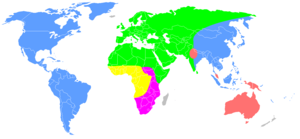FULL WIKIPEDIA ARTICLE
Origin of the concept[edit]
The term "Caucasian race" was coined by the German philosopher Christoph Meiners in his The Outline of History of Mankind (1785).[page needed] Meiners' term was given wider circulation in the 1790's by Johann Friedrich Blumenbach, a German professor of medicine and member of the British Royal Society, who is considered one of the founders of the discipline of anthropology.[6]
Meiners' treatise was widely read in the German intellectual circles of its day, despite muted criticism of its scholarship. Meiners proposed a taxonomy of human beings based on two races (Rassen): Caucasians and Mongolians. He considered Caucasians to be more physically attractive than Mongolians, notably because they had paler skin; he claimed Caucasians were also more sensitive and more morally virtuous than Mongolians. Later he would make similar distinctions within the Caucasian group, concluding that the Germans were the most attractive and virtuous people on earth. The name "Caucasian" derived from the Southern Caucasus/Transcaucasia region (or what are now the countries of Armenia, Azerbaijan and Georgia) because he considered the people of this region to be the archetype (cf. taxonomical "neotype") for the grouping.
Meiners' classification was not grounded on any scientific criteria. It was Blumenbach who gave it scientific credibility and a wider audience, by grounding it in the new quantitative method of craniometry. Blumenbach did not credit Meiners with his taxonomy, however, claiming to have developed it himself — although his justification clearly points to Meiners' aesthetic viewpoint of Caucasus origins:
Relation to skin color[edit]
Main article: White people
In his earlier racial typology, Meiners put forth that Caucasians had the "whitest, most blooming and most delicate skin".[8] In a series of articles, Meiners boasts about the superiority of Germans among Europeans, and describes non-German Europeans' color as "dirty whites", in an unfavorable comparison with Germans.[9] Such views were typical of early scientific attempts at racial classification, where skin pigmentation was regarded as the main difference between races.[citation needed] This view was shared by the French naturalist Julien-Joseph Virey, who believed that the Caucasians were only the palest-skinned Europeans.[10]
In various editions of On the Natural Variety of Mankind, Blumenbach expanded on Meiners' popular idea and defined five human races based on color, using popular racial terms of his day, justified with scientific terminology, cranial measurements, and facial features. He established Caucasian as the "white race," as well as Mongoloid as the "yellow race," Malayan the "brown race," Ethiopian the "black race," American the "red race." [11] In the 3rd edition of his On the Natural Variety of Mankind, Blumenbach moved skin tone to second-tier importance after noticing that poorer European people (such as peasants) whom he observed generally worked outside, often became darker skinned ("browner") through sun exposure.[12] He also noticed that darker skin of an "olive-tinge" was a natural feature of some European populations closer to the Mediterranean Sea.[13] Alongside the anthropologist Georges Cuvier, Blumenbach classified the Caucasian race by cranial measurements and bone morphology in addition to skin pigmentation, and thus considered more than just the palest Europeans ("white, cheeks rosy") as archetypes for the Caucasian race.[14]
Among the proponents of the concept there was never any consensus on the delineation between the Caucasoid race, including the populations of Europe, and the Mongoloid race, including the populations of East Asia. Thus, Carleton S. Coon (1939) and Franco Bragagna (2013) included the populations native to all of Central and Northern Asia under the Caucasoid label. However, many scientists maintained the racial categorizations of color established by Meiners' and Blumenbach's works, along with many other early steps of anthropology, well into the late 19th and mid-to-late 20th centuries, increasingly used to justify political policies, such as segregation and immigration restrictions, and other opinions based in prejudice. For example,Thomas Henry Huxley (1870) classified all populations of Asian nations as Mongoloid. Lothrop Stoddard (1920) in turn classified as "brown" most of the populations of the Middle East, North Africa, the Horn of Africa, Central Asia and South Asia. He counted as "white" only European peoples and their descendants, as well as a few populations in areas adjacent to or opposite southern Europe, in parts of Anatolia and parts of the Rif and Atlas mountains.
On the whole, Caucasoid traits were traditionally held to be independent from skin tone.[3] Accordingly, analysis of 8,500 year old hunter-gatherers from sites in Western and Southern Europe has found that many carried ancestral skin pigmentation variants. As such, these early specimens would have been darker-skinned than present-day Europeans, but otherwise biologically similar.[15]


No comments:
Post a Comment